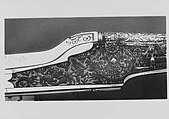Wheellock Rifle
Steel-chiseler Daniel Sadeler German
Stock maker Hieronymus Borstorffer German
The dukes of Bavaria were enthusiastic collectors who assembled exotic objects and works of art in a special gallery called a Kunstkammer. In the capital city of Munich, they established various workshops where the most skillful artists and craftsmen produced art objects for the princely collection or for presentation to foreign dignitaries. Among the artists employed by the Munich court were the steel-chiselers Emanuel Sadeler (active 1594–1610), his brother Daniel (recorded 1602–32), and Caspar Spät (about 1611–1691). Unlike other artists decorating steel, the Munich masters did not depend on gold to produce stunning effect but used it mainly as a background to emphasize the ornament in blued steel chiseled in high relief. The subjects and patterns of decoration were usually inspired by mannerist designs produced by Flemish and French artists of the second half of the sixteenth century. Masters of carving and engraving on wood, ivory, and horn, such as Hieronymus Borstorffer (recorded 1597–1637) and Elias Becker (recorded 1633–74), were called upon to create embellished gunstocks of the highest quality to match the magnificent barrels and locks by the Sadelers and by Spät.
Due to rights restrictions, this image cannot be enlarged, viewed at full screen, or downloaded.

